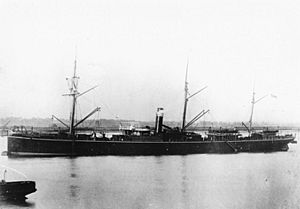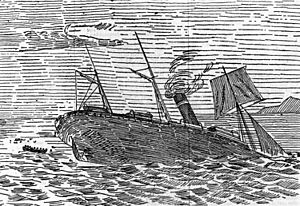RMS Quetta facts for kids
class="infobox " style="float: right; clear: right; width: 315px; border-spacing: 2px; text-align: left; font-size: 90%;"
| colspan="2" style="text-align: center; font-size: 90%; line-height: 1.5em;" | 
|}
The RMS Quetta was a special mail ship that sank off the coast of Far North Queensland, Australia, on February 28, 1890. This terrible accident killed 134 out of 292 people on board. It was one of Queensland's worst ship disasters. The Quetta hit a hidden rock in the Adolphus Channel.
Contents
| History | |
|---|---|
| Name | Quetta |
| Owner | British-India SN Co |
| Operator | British-India SN Co |
| Launched | March 1881 |
| Fate | Wrecked 28 February 1890 after hitting rocks near the Torres Straits |
| General characteristics | |
| Tonnage | 3,300 GRT |
| Length | 380 ft (120 m) |
| Beam | 40 ft (12 m) |
| Propulsion | steam & sail |
| Speed | Over 13 knots (24 km/h) |
| Capacity |
|
About the RMS Quetta Ship
The RMS Quetta was a large ship owned by the British-India Steam Navigation Company. It sailed between England, India, and the Far East. The Queensland Government wanted a direct shipping service between the United Kingdom and Brisbane. This would make travel and mail delivery easier.
Building the Quetta for Australia
The Quetta was built especially for the Australia route. It even had a special cooling system for carrying frozen meat. The ship was launched in March 1881. Its first trip to Brisbane was in 1883.
The letters "RMS" in its name stand for Royal Mail Ship. This showed its important role in carrying mail for the Queensland Royal Mail Line. The Quetta had two sister ships named Manora and Merkara.
Passenger Capacity and Changes
The ship was first designed to carry 72 first-class passengers and 32 second-class passengers. However, this was later changed. More space was made for second-class passengers. This was because many people moving to Australia used this service.
Over five and a half years, the Quetta made 11 round trips between London and Brisbane. Its twelfth trip would sadly be its last.
The Quetta Ship Disaster
On the night of February 28, 1890, Captain Sanders was in charge of the ship. Captain Keatinge was also on board, guiding the ship through the Torres Strait. The ship was heading for Thursday Island. It turned into the Adolphus Channel to go around the Cape York Peninsula.
What Caused the Sinking?
The pilot guiding the ship was very experienced. The weather was good, and it was easy to see. But at 9:14 PM, the ship hit a rock that was not on any map. This happened in the middle of the channel, near Albany Island.
The rock tore a huge hole in the ship's bottom. The hole was between four and 12 feet wide. It stretched from the front of the ship to the engine room in the middle. The Quetta sank in just 5 minutes. This quick sinking led to the deaths of 134 passengers. At the time, this was Queensland's worst ever shipping disaster.
Who Was On Board?
When the disaster happened, 292 people were on the Quetta.
- There were 121 crew members. This included 15 European officers, 14 from other jobs, and 92 lascars (sailors from India).
- There were 70 Javanese people. They were traveling to Batavia after working in sugar cane fields. They were staying in temporary shelters on the deck.
- There were 101 other passengers.
| People on board when the disaster happened | ||
|---|---|---|
| Group | Number on board | Survival rate |
| Javanese passengers | 70 | 79% |
| Lascar crew | 92 | 78% |
| First-class passengers | 26 | 19% |
| Second-class passengers | 75 | 86% |
| European officers | 15 | |
| Crew (other jobs) | 14 | |
| Total | 292 | 54% |
Rescue Efforts and Survivors
One of the ship's small boats, called a cutter, floated free. It turned over, and many Javanese and lascar sailors were around it. Quartermaster James Oates helped empty the water from the cutter. They then headed towards the shore.
Only one of the ship's lifeboats survived the sinking. This was Lifeboat Number 1 on the starboard (right) side. It was controlled by the third officer, Thomas Babb. This lifeboat was damaged and mostly filled with water. As it moved towards shore, it picked up more survivors, including Captain Sanders.
Around midnight, the two boats met. Everyone was taken to the nearest island. Captain Sanders then sent the cutter back to look for more survivors.
After spending a night and a day without food or water, the main group of 98 survivors was rescued. Two ships, the Albatross and the Merrie England, had been sent from Thursday Island's Port Kennedy to search for them.
The Albatross used special equipment to find the rock that caused the disaster. It was about half a mile from where the Quetta sank. Items recovered from the wreck can be seen in the Quetta Memorial Church on Thursday Island. This church was built in 1893.
Today, the Quetta lies on its left side in 18 meters (59 feet) of water. It is a protected historic shipwreck under Australia's Historic Shipwrecks Act 1976.
Memorials to the Quetta
To remember the lives lost on the Quetta, the Quetta Memorial Precinct was created on Thursday Island. This area includes a church (which later became a cathedral), a rectory (a house for a priest), and a church hall.
Notable Passengers on the Quetta
Many important people were on board the Quetta when it sank. Some of them sadly died in the disaster.
- Claudius Buchanan Whish and his wife, Anne Ker Whish, both died.
- John Watson of Watson, Ferguson and Company and his wife, Elizabeth Selim Watson, both died.
- George Prentice (70) and Jessie Blanche Prentice (18) also died. George was the grandfather and Jessie was the half-sister of George Gray Prentice.
- Alexander Archer, who managed the Bank of New South Wales in Brisbane, died. His wife, Mary Louisa, who was the daughter of Sir Robert Mackenzie, 10th Baronet, also died. Alexander was the brother of Archibald Archer.
- Reuben Nicklin and his wife, Jane Lahey Nicklin, both died. They were the grandparents of Frank Nicklin, who later became the Premier of Queensland. Jane Lahey Nicklin was the daughter of a rich timber merchant named Francis Lahey. Her brothers started Lahey's Canungra Sawmill. The Nicklin family home, "Hatherton," later became the Queen Alexandra Home.
- Their 19-year-old daughter, Alice Elizabeth Nicklin, was one of the few female survivors. She was a strong swimmer. She held onto floating things like a grate, then a dead sheep, and then a plank. She was in the dark, moonless water, sometimes sleeping and paddling on the plank. She finally reached shore about three hours into the next day.


